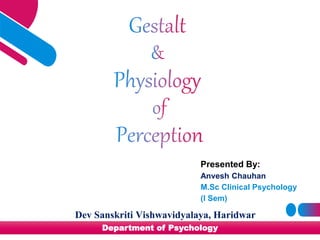
Physiology of perception
- 1. Presented By: Anvesh Chauhan M.Sc Clinical Psychology (I Sem) Department of Psychology Dev Sanskriti Vishwavidyalaya, Haridwar
- 2. The Gestalt Psychology was founded in early 20th century by German psychologists Max Wertheimer, Kurt Koffka and Wolfgang Kohler and they focused on how people interpret the world. In order to better understand how human perception works, Gestalt psychologists proposed a number of laws of perceptual organization.
- 3. ORGANISING Figure Background, Grouping SELECTING STIMULI External- Size, Nature, Location Internal- Age,Need,Interest RECEIVING STIMULI External Internal INTERPRETATING Attribution, Stereotyping, Projection RESPONSE Covert Overt
- 4. This approach is concerned with- “Determining the biological mechanisms responsible for perception.” These physiological mechanisms begin when receptors sensitive to specific kinds of stimuli -light for vision, sound for hearing, etc. are activated and trigger electrical signals that eventually result in activation of neurons in a large number of structures, both before reaching the brain and then within the complex architecture of a large number of interrelated brain areas.
- 5. It has determined how stimuli in the environment are represented by the firing of neurons and activation of the brain, and has demonstrated connections between specific areas of the brain and the perception of specific types of stimuli . For example, Visual patterns such as faces, complex sounds, and chemical compounds with specific structural components have been linked to specific brain areas.
- 6. A.Stimuli for Perception B.The Attended Stimulus C.Receptor Activity and Molecular Processes D.Neural Processing and Neural Responding E.Organization of Sensory Systems F.The Sensory Code G.Perception H.Recognition I.Action
- 7. Stimuli for Perception the attended stimulus A stimulus is everything in our environment that has the potential to be perceived. This might include anything that can be seen, touched, tasted, smelled, or heard. The specific object in the environment on which our attention is focused. In many cases, we might focus on stimuli that are familiar to us.
- 8. neural processing and neural …….responding: Receptor activity and molecular ……..processes: Receptors help determine which aspects of stimuli are represented in the nervous system. For example, for vision, light-sensitive pigments in receptors are activated by specific wavelengths of light. The basis of neural processing is excitation and inhibition. Relationships that have been established between characteristics of stimuli and physiological responding form the backbone of the idea that stimuli in the environment are represented by firing in the nervous system.
- 10. organization of sensory systems: the sensory code: Activity from senses, such as visual stimuli extends from the primary visual receiving area in the occipital lobe to the temporal and parietal lobes and for Audition and the tactile senses, also extends beyond their primary receiving areas, and activity generated by all of the senses extends into the frontal lobe. Specialized areas do exist, but activity for a specific stimulus is often widely distributed throughout the brain. (1)Specificity coding – few neurons (2)Sparse coding- small number of neurons (3)Distributed coding- large numbers of neuron
- 11. perception : recognition: The final step of the perceptual process involves some sort of action in response to the environmental stimulus. The action phase of perceptual development involves some type of motor activity that occurs in response to the perceived and recognized stimulus. Now, we actually perceive the stimulus object in the environment. It is at this point that we become consciously aware of the stimulus. Our ability to interpret and give meaning to the object is known as recognition. It is an essential part of perception since it allows us to make sense of the world around us. action:
- 12. • The Encyclopedia of Perception- E. Bruce Goldstein • Perception and the Perceptual Process- www.verywellmind.com • Physiolocial Approach- sk.sagepub.com • Psychology- Ciccarelli and White • UGC-NET Psychology- R.Gupta’s • https://www.verywellmind.com/what-is-gestalt-psychology-2795808